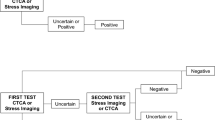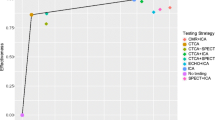Abstract
Several non-invasive imaging techniques are currently in use for the diagnostic workup of adult patients with stable chest pain suspected of having coronary artery disease (CAD). In this paper, we present a systematic overview of the evidence on diagnostic performance and comparative cost-effectiveness of new modalities in comparison to established technologies. A literature search for English language studies from 2009 to 2013 was performed, and two investigators independently extracted data on patient and study characteristics. The reviewed published evidence on diagnostic performance and cost-effectiveness support a strategy of CTCA as a rule out (gatekeeper) test of CAD in low- to intermediate-risk patients since it has excellent diagnostic performance and as initial imaging test is cost-effective under different willingness-to-pay thresholds. More cost-effectiveness research is needed in order to define the role and choice of cardiac stress imaging tests.





Similar content being viewed by others
Abbreviations
- CAD:
-
Coronary artery disease
- CAG:
-
Catheter-based (invasive) coronary angiography
- CMR:
-
Cardiac magnetic resonance imaging
- CTCA:
-
CT coronary angiography
- FFR:
-
Fractional flow reserve
- MRI:
-
Magnetic resonance imaging
- MPI:
-
Myocardial perfusion imaging
- MPS:
-
Myocardial perfusion spectroscopy
- PET:
-
Positron emission tomography
- QALY:
-
Quality-adjusted life year
- SE:
-
Stress echocardiography
- SPECT:
-
Single photon emission computed tomography
- XECG:
-
Stress electrocardiography
References
Papers of particular interest, published recently, have been highlighted as: • Of importance •• Of major importance
World Health Organization. The Global burden of disease: 2004 update. 2008 05-02-2014]; Available from: http://www.who.int/healthinfo/global_burden_disease/2004_report_update/en/.
Lloyd-Jones DM et al. Framingham risk score and prediction of lifetime risk for coronary heart disease. Am J Cardiol. 2004;94(1):20–4.
Hemingway H et al. Prevalence of angina in women versus men: a systematic review and meta-analysis of international variations across 31 countries. Circulation. 2008;117(12):1526–36.
Sekhri N et al. Incremental prognostic value of the exercise electrocardiogram in the initial assessment of patients with suspected angina: cohort study. BMJ. 2008;337:a2240.
Beltrame JF et al. The prevalence of weekly angina among patients with chronic stable angina in primary care practices: the coronary artery disease in general practice (CADENCE) study. Arch Intern Med. 2009;169(16):1491–9.
Cooper A, Timmis A, Skinner J. Assessment of recent onset chest pain or discomfort of suspected cardiac origin: summary of NICE guidance. BMJ (Online). 2010;340(7749):757.
Fihn SD et al. ACCF/AHA/ACP/AATS/PCNA/SCAI/STS guideline for the diagnosis and management of patients with stable ischemic heart diseases. Circulation. 2012;126(25):e354–471. This paper reports the most recent guidelines for the workup of patients with chest pain suspected of having CAD. These guidelines are for the USA. The most recent European guidelines were published in 2006 (see Fox, reference 8) and those for the UK were published in 2010 (see Cooper, reference 6).
Fox K et al. Guidelines on the management of stable angina pectoris: executive summary: the task force on the management of stable angina pectoris of the european society of cardiology. Eur Heart J. 2006;27(11):1341–81.
Wijns W et al. Guidelines on myocardial revascularization. Eur Heart J. 2010;31(20):2501–55.
Heijenbrok-Kal MH, Fleischmann KE, Hunink MG. Stress echocardiography, stress single-photon-emission computed tomography and electron beam computed tomography for the assessment of coronary artery disease: a meta-analysis of diagnostic performance. Am Heart J. 2007;154:415–23.
Moher D et al. Preferred reporting items for systematic reviews and meta-analyses: the PRISMA statement. BMJ. 2009;339:b2535.
Husereau D et al. Consolidated Health Economic Evaluation Reporting Standards (CHEERS) statement. Value Health. 2013;16(2):e1–5.
Abdulla J et al. Evaluation of aortic valve stenosis by cardiac multislice computed tomography compared with echocardiography: a systematic review and meta-analysis. J Heart Valve Dis. 2009;18(6):634–43.
Springer I, Dewey M. Comparison of multislice computed tomography with intravascular ultrasound for detection and characterization of coronary artery plaques: a systematic review. Eur J Radiol. 2009;71(2):275–82.
von Ballmoos MW et al. Meta-analysis: diagnostic performance of low-radiation-dose coronary computed tomography angiography. Ann Intern Med. 2011;154(6):413–20.
Pontone G et al. Radiation dose and diagnostic accuracy of multidetector computed tomography for the detection of significant coronary artery stenoses: a meta-analysis. Int J Cardiol. 2012;160(3):155–64.
Salavati A et al. Dual-source computed tomography angiography for diagnosis and assessment of coronary artery disease: systematic review and meta-analysis. J Cardiovasc Comput Tomogr. 2012;6(2):78–90.
Li S et al. Diagnostic accuracy of 320-slice computed tomography angiography for detection of coronary artery stenosis: meta-analysis. Int J Cardiol. 2013;168(3):2699–705.
Schuetz GM et al. Meta-analysis: noninvasive coronary angiography using computed tomography versus magnetic resonance imaging. Ann Intern Med. 2010;152(3):167–77.
Hamon M et al. Meta-analysis of the diagnostic performance of stress perfusion cardiovascular magnetic resonance for detection of coronary artery disease. J Cardiovasc Magn Reson. 2010;12(1):29.
Desai RR, Jha S. Diagnostic performance of cardiac stress perfusion MRI in the detection of coronary artery disease using fractional flow reserve as the reference standard: a meta-analysis. AJR Am J Roentgenol. 2013;201(2):W245–52.
de Jong MC et al. Diagnostic performance of stress myocardial perfusion imaging for coronary artery disease: a systematic review and meta-analysis. Eur Radiol. 2012;22(9):1881–95.
Jaarsma C et al. Diagnostic performance of noninvasive myocardial perfusion imaging using single-photon emission computed tomography, cardiac magnetic resonance, and positron emission tomography imaging for the detection of obstructive coronary artery disease: a meta-analysis. J Am Coll Cardiol. 2012;59(19):1719–28.
Mc Ardle BA et al. Does rubidium-82 PET have superior accuracy to SPECT perfusion imaging for the diagnosis of obstructive coronary disease?: a systematic review and meta-analysis. J Am Coll Cardiol. 2012;60(18):1828–37.
Iskandar A et al. Gender differences in the diagnostic accuracy of SPECT myocardial perfusion imaging: a bivariate meta-analysis. J Nucl Cardiol. 2013;20(1):53–63.
Amemiya S, Takao H. Computed tomographic coronary angiography for diagnosing stable coronary artery disease—a cost-utility and cost-effectiveness analysis. Circ J. 2009;73(7):1263–70.
Genders TSS et al. CT coronary angiography in patients suspected of having coronary artery disease: decision making from various perspectives in the face of uncertainty. Radiology. 2009;253(3):734–44.
Kreisz FP et al. The pre-test risk stratified cost-effectiveness of 64-slice computed tomography coronary angiography in the detection of significant obstructive coronary artery disease in patients otherwise referred to invasive coronary angiography. Heart Lung Circ. 2009;18(3):200–7.
Catalan P, Callejo D, Blasco JA. Cost-effectiveness analysis of 64-slice computed tomography vs. cardiac catheterization to rule out coronary artery disease before non-coronary cardiovascular surgery. Eur Heart J Cardiovasc Imaging. 2013;14(2):149–57.
Min JK et al. Cost-effectiveness of coronary CT angiography versus myocardial perfusion SPECT for evaluation of patients with chest pain and no known coronary artery disease. Radiology. 2010;254(3):801–8.
Meyer M et al. Cost-effectiveness of substituting dual-energy CT for SPECT in the assessment of myocardial perfusion for the workup of coronary artery disease. Eur J Radiol. 2012;81(12):3719–25.
Genders TSS et al. Coronary computed tomography versus exercise testing in patients with stable chest pain: comparative effectiveness and costs. Int J Cardiol. 2013;167(4):1268–75.
Ladapo JA et al. Clinical outcomes and cost-effectiveness of coronary computed tomography angiography in the evaluation of patients with chest pain. J Am Coll Cardiol. 2009;54(25):2409–22.
Iwata K, Ogasawara K. Comparison of the cost-effectiveness of stress myocardial perfusion MRI and SPECT in patients with suspected coronary artery disease. Radiol Phys Technol. 2013;6(1):28–34.
Boldt J et al. Cost-effectiveness of cardiovascular magnetic resonance and single-photon emission computed tomography for diagnosis of coronary artery disease in Germany. J Cardiovasc Magn Reson. 2013;15(1):30.
Walker S et al. Cost-effectiveness of cardiovascular magnetic resonance in the diagnosis of coronary heart disease: an economic evaluation using data from the CE-MARC study. Heart. 2013;99(12):873–81.
Mahajan N et al. Diagnostic accuracy of myocardial perfusion imaging and stress echocardiography for the diagnosis of left main and triple vessel coronary artery disease: a comparative meta-analysis. Heart. 2010;96(12):956–66.
Genders TSS et al. Prediction model to estimate presence of coronary artery disease: retrospective pooled analysis of existing cohorts. Br Med J. 2012;344:e3485. This study provides a prediction model for predicting the prior probability of coronary artery disease (CAD) in patients with chest pain. The prediction model is based on a meta-analysis of individual patient-level data. The model can be used to guide further management in patients with chest pain.
Compliance with Ethics Guidelines
Conflict of Interest
Claudia N. van Waardhuizen, Marieke Langhout, Felisia Ly, Loes Braun, Tessa S.S. Genders, Kirsten E. Fleischmann and Koen Nieman declare that they have no conflict of interest.
Steffen E. Petersen has been a consultant to Circle Cardiovascular Imaging Inc., Calgary, Canada.
M. G. Myriam Hunink reports royalties from Cambridge University Press, travel reimbursement and grants from European Society of Radiology (ESR) and travel reimbursement and Member of Scientific Advisory Board from European Institute for Biomedical Imaging Research.
Human and Animal Rights and Informed Consent
This article does not contain any studies with human or animal subjects performed by any of the authors.
Author information
Authors and Affiliations
Corresponding author
Additional information
This article is part of the Topical Collection on Cardiac PET CT, and MRI
Rights and permissions
About this article
Cite this article
van Waardhuizen, C.N., Langhout, M., Ly, F. et al. Diagnostic Performance and Comparative Cost-Effectiveness of Non-invasive Imaging Tests in Patients Presenting with Chronic Stable Chest Pain with Suspected Coronary Artery Disease: A Systematic Overview. Curr Cardiol Rep 16, 537 (2014). https://doi.org/10.1007/s11886-014-0537-9
Published:
DOI: https://doi.org/10.1007/s11886-014-0537-9




